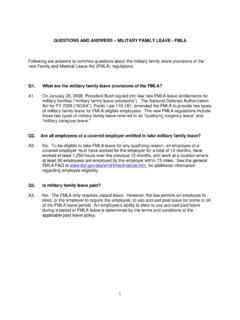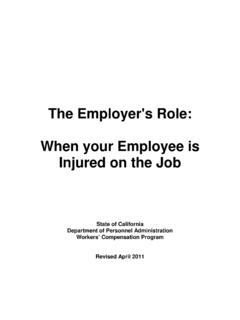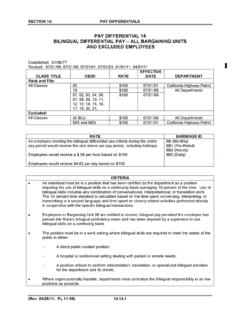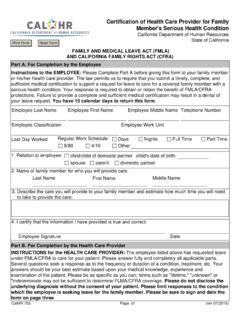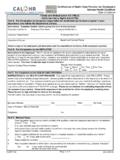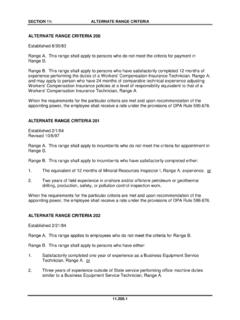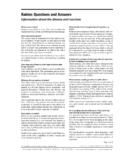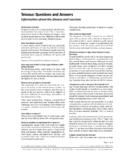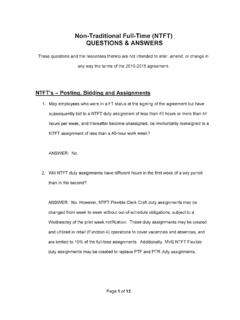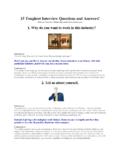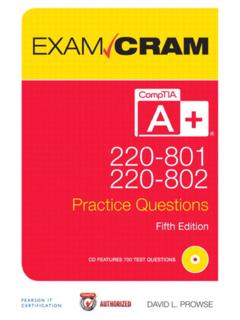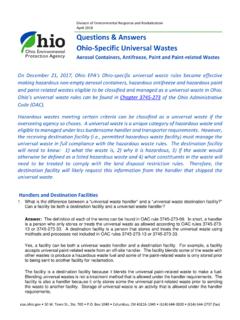Transcription of QUESTIONS AND ANSWERS FMLA - California
1 QUESTIONS AND ANSWERS fmla . Following are ANSWERS to commonly asked QUESTIONS about the new Family and Medical Leave Act ( fmla ) regulations. The effective date of the revised fmla regulations is January 16, 2009. The California Family Rights Act (CFRA) is a State law that also provides for unpaid leaves of absence for family reasons or for the employee's own illness. Where the fmla law and the CFRA law differ, the most generous/less restrictive leave provisions must be applied. Qualifying Reasons for fmla Leave 1. Q. Can I still use fmla /CFRA leave during pregnancy or after the birth of a child?
2 A. Yes. An employee's ability to use fmla leave during pregnancy or after the birth of a child has not changed. Under the regulations, a mother can use 12 weeks of fmla leave for the birth of a child, for prenatal care and incapacity related to pregnancy, and for her own serious health condition following the birth of a child. A father can use fmla leave for the birth of a child and to care for his spouse who is incapacitated (due to pregnancy or child birth). Note: Under CFRA the employee is entitled to Pregnancy Disability Leave (PDL). and an eligible employee can take 12 weeks of CFRA for bonding.
3 The first 12. weeks of PDL can run concurrently with fmla . 2. Q. Are there any changes to the definition of a serious health condition under the regulations? A. No. A serious health condition is defined as an illness, injury, impairment, or physical or mental condition that involves inpatient care or continuing treatment by a health care provider. Eligibility for fmla Leave 1. Q. I have 12 months of service with my employer, but they are not consecutive. Do I still qualify for fmla ? A. You may. In order to be eligible to take leave under the fmla , an employee must (1) work for a covered employer, (2) work 1,250 hours during the 12 months prior to the start of leave, (3) work at a location where 50 or more employees work at that location or within 75 miles of it, and (4) have worked for the employer for 12 months.
4 The 12 months of employment are not required to be consecutive in order for the employee to qualify for fmla leave. 2. Q. If I have to miss work due to National Guard or Reserve duty, will this affect my eligibility for fmla leave? A. No. The regulations make clear the protections for our men and women serving in the military by stating that a break in service due to an employee's fulfillment of military obligations must be taken into consideration when determining whether an employee has been employed for 12 months or has the required 1,250 hours of service. Under the Uniformed Services Employment and Reemployment Rights Act of 1994 (USERRA), hours an employee would have worked but for his or her military service are credited toward the employee's required 1,250 hours worked for fmla eligibility.
5 Similarly, the time in military service also must be counted in determining whether the employee has been employed at least 12 months by the employer. Example: Dean worked for his employer for six months in 2008, then was called to active duty status with the Reserves and deployed to Iraq. In 2009, Dean returned to his employer, requesting to be reinstated under the USERRA. Both the hours and the months Dean would have worked but for his military status must be counted in determining his fmla eligibility. Employer Notice Requirements 1. Q. What are an employer's posting and general notice requirements?
6 A. Employers must post a general notice explaining the fmla 's provisions and providing information regarding procedures for filing a claim under the Act in a conspicuous place where it can be seen by employees and applicants. Under the regulations, this posted notice includes additional information regarding the definition of a serious health condition, the new military family leave entitlements, and employer and employee responsibilities. Employers must also include the information in this general notice in any employee handbook or other written policies or manuals describing employee benefits and leave provisions.
7 Additionally, under the regulations, an employer without a handbook or written guidance is required to provide this general notice to new employees upon hiring. 2. Q. How soon after an employee provides notice of the need for leave must an employer determine whether someone is eligible for fmla leave? A. Absent extenuating circumstances, the regulations require an employer to notify an employee of whether the employee is eligible to take fmla leave (and, if not, at least one reason why the employee is ineligible) within five business days of the employee requesting leave or the employer learning that an employee's leave may be for a fmla -qualifying reason.
8 2. 3. Q. Does an employer have to provide employees with information regarding their specific rights and responsibilities under the fmla ? A. Yes. At the same time an employer provides an employee notice of the employee's eligibility to take fmla leave, the employer must also notify the employee of the specific expectations and obligations associated with the leave. Among other information included in this notice, the employer must inform the employee whether the employee will be required to provide certification of the fmla -qualifying reason for leave and the employee's right to substitute paid leave (including any conditions related to such substitution, and the employee's entitlement to unpaid fmla leave if those conditions are not met).
9 If the information included in the Notice of Eligibility and Rights and Responsibilities (DPA 752) changes, the employer must inform the employee of such changes within five business days of receipt of the employee's first notice of the need for fmla leave subsequent to any change. Employers are expected to responsively answer QUESTIONS from employees concerning their rights and responsibilities. 4. Q. How soon after an employee provides notice of the need for leave must an employer notify an employee the leave will be designated and counted as fmla leave? A. Under the regulations, an employer must notify an employee whether leave will be designated as fmla leave within five business days of learning the leave is being taken for a fmla -qualifying reason, absent extenuating circumstances.
10 The designation notice must also state whether the employer will require the employee to provide a return-to-work release to return to work (unless a handbook or other written document clearly provides that such certification will be required in specific circumstances, in which case the employer may provide oral notice of this requirement). Additionally, if the amount of leave needed is known, an employer must inform an employee of the number of hours, days, or weeks that will be counted against the employee's fmla leave entitlement in the designation notice. Where it is not possible to provide the number of hours, days, or weeks that will be counted as fmla leave in the designation notice ( where the leave will be unscheduled), an employer must provide this information upon request by the employee, but no more often than every 30 days and only if leave was taken during that period.
